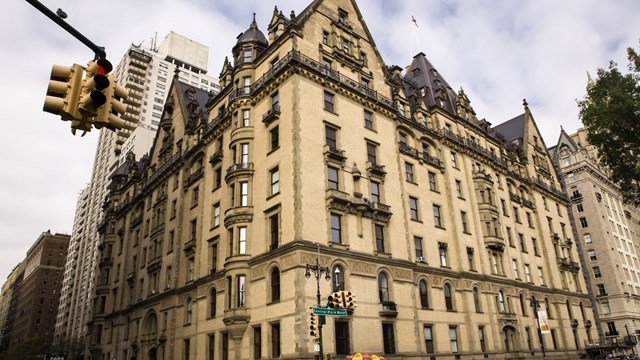Property maintenance is a major responsibility of ownership. In many unique ways, maintenance programs in a co-op or condo buildings – especially in older properties having architectural or design features with important artistic histories – may present more complex requirements. These complexities become even more pronounced when a property has official landmark status or is situated in a landmark neighborhood.
Landmark’s Mission, and the Reality of Preservation
The New York City Administrative Code states the following to clarify its position on landmarking and historic preservation: “It is hereby declared as a matter of public policy that the protection, enhancement, perpetuation and use of improvements and landscape features of special character or special historical or aesthetic interest or value is a public necessity and is required in the interest of the health, prosperity, safety and welfare of the people.” Preservation programs are generally viewed as being in the best interest of a community, and historic designations and the awarding of landmark status to buildings, blocks, or even whole neighborhoods are usually well-received by communities and their residents.
Patrick Rosen is an architect and partner with Chicago-based Rosen Architecture. He has worked on many projects that have official landmark status, as well as properties without landmark designation, but which have a high level of artistic and historical architectural significance that both the municipality and the property owner seek to preserve. “The landmark thing is a little tricky,” Rosen says. “Chicago has an ordinance resulting from an incident that occurred 12 or 15 years ago where a woman was killed by a piece of glass that fell off of a building. In reaction, an ordinance was instituted that any building over 80 feet in height must be inspected annually. They are particularly concerned with these historic buildings that have terracotta or cornices, regardless of landmark status.”
At least two similar incidences have occurred in New York City in recent years, resulting in similar ordinances, and the sudden appearance of scaffolding surrounding many buildings throughout the city. The move to improve building safety has had an ironic side-effect: the omnipresent scaffolds and sidewalk sheds have recently come under scrutiny by the local media as contributing to crime, and an increase in vermin.
In Chicago, Rosen explains, “The way it works is that any building that has any kind of historic designation will automatically get a hold on any work submitted to the building department for approval when a repair or a renovation is required. You can’t go through the process with the Building Department till you go through the Landmarks Department.” The same is true in New York.
There is clearly the same intention in New York City as indicated by language in the New York City ordinance. But as Rosen points out, “There is a lot of subjectivity involved.” He indicates that Landmarks Commissions are often populated by architects or other people knowledgeable in the history of both the properties and the community, and that many of them have strong opinions, which sometimes can be seen by others as subjective. “Their main concern is that what you’re doing will not disrupt the character of the building or district.”
One important question is whether the additional scrutiny and potential efforts needed to safeguard the historical, architectural and artistic aspects of a property will add to the cost of a project. “No,” says Rosen. “It does not necessarily increase costs, but it does slow down the process considerably.”
A Surprise Decision
One fascinating project described by Rosen involved a four-story townhouse constructed in the 1880s in the Queen Anne Victorian style and renovated in the 1930s, long before the movement for historic preservation began. The 1930s renovation included a change in the architectural style of the building façade to an Art Deco look, popular at that time. The owners wanted to return the property to its original look, thereby matching the surrounding properties. They assumed the Landmarks Commission would be delighted with their plans. To the contrary – one senior member of the commission said that what the architect did in the 1930s renovation was in itself actually even more special than the original structure. “That change in the 1930s – which would never be permitted now – was considered worth preserving,” says Rosen. The commission said no to the proposed change. “It turns out in hindsight that I agree with the decision,” Rosen adds. “After doing the research, we traced that 1930s alteration to Edgar Miller, a noted architect of that time.”
Choosing to Maintain Your History
Victor C. Farrar designed London Terrace Towers, located on West 23rd and West 24th Streets in the Chelsea section of Manhattan. The hulking property is comprised of four separate buildings and contains approximately 700 units. Construction on the co-op was completed in 1930, and though not in a landmark district or designated as such, the property is considered an excellent example of the Art Deco design sensibilities of the period. The building contains an Olympic-size swimming pool, which is in itself a design wonder. The co-op board decided to undertake a restoration of the pool and health club, which is currently underway.
As Cythia Graffeo, the building’s managing agent and a general manager with Douglas Elliman explains, “The board considers the pool an historic and significant place that we are treating like a piece of art, as recommended by an architectural conservation company that the board engaged to provide an assessment of the existing pool condition.”
Cherylyn Lavagnino is vice president of the London Terrace board, as well as a member of the community’s pool and health club committee, and a resident of the building for over 20 years. As she explains, “We have very special tiles in the pool that were designed by Ernest Batchelder, and which are extremely costly and of both artistic and historical value. The tilework is one of the most beautiful elements.”
Batchelder was a tile maker who was a leader in the American Arts and Crafts movement. “We decided to retain as many of the original elements as possible, the tiles being one example,” says Graffeo. “In order to maintain the original look, we found original tiles to replace those that had deteriorated in the past. The grills on the ceiling had been painted over, so we stripped the paint and restored the original brass.”
Lavagnino and Graffeo both acknowledge that a simple upgrade would have been less expensive and a much shorter project, but would not have achieved the same result. Additionally, the project did not have an effect on regular maintenance costs. “We expect a large rebate from the state of New York shortly,” says Lavagnino, “resulting from energy incentives from converting our boilers from #6 oil to dual fuel, so we took that money and put it towards restoring both the pool and health club.”
A Small Building with a Plan
Another interesting case study is the lobby renovation at 736 West 186th Street in Washington Heights, located in upper Manhattan. Built in 1930s’, the six-story, 54-unit elevator property has Art Deco accents, but has undergone alterations over the past nearly 80 years that have hidden many of them. The co-op board decided to undertake a restoration of the lobby, the plan for which was developed over several years. Ray Levy, a member of both the co-op board and the lobby committee, explained that the board set up a committee to determine the best route to present a more appealing lobby, both for residents as well as potential buyers. “We spent a good deal of time researching other Art Deco buildings to see what their lobbies looked like and then to find out about buildings where they had upgraded their lobby,” he says. The committee and then the board decided to pursue a restoration of sorts to maintain and enhance the Deco details of the lobby area, including a restoration of a mural on the elevator door and a deco-style light with the building number over the front entrance that had been hidden for decades by an awning.
Based upon their research, “We identified two potential architects with similar experience who could take on a relatively small project like this one,” said Levy. The project did take longer than expected – which often is the case in a restoration rather than an upgrade – but Levy reports that the committee, the board and the residents are very happy with the results.
How Does it Work?
Organizing your restorations, maintenance and projects is not a simple or standard task. Are committees permanent or temporary? How much autonomy do they have to make design and spending decisions? How much time do committee members have to devote to a project? The answers to these questions may depend to a great extent on the building. Rosen says, “In my experience, landmark co-ops and condos don’t necessarily have standing committees to deal with these issues. They form committees as they need them that specifically deal with preservation.”
Some larger properties like London Terrace have a standing committee for certain elements and projects – like their pool and health club restoration. Other buildings, such as 736 West 186th Street, form a special committee to first research then to direct the project. Levy says, “The time commitment started at perhaps four hours per month. As the project progressed, it got more involved.”
Lavagnino concurs. “I spend a minimum of 10 to 12 hours per week working for this committee. It’s like a part-time job. I’m serving on another committee as well right now. It’s all quite involved.”
Project completion involves a lot of participation from many different quarters. The specific committee will generally complete the initial research, make recommendations for the project’s path and review the day-to-day progress of the work. The overall decisions to move forward are usually made by the board and executed by the managing agent. In turn, architects and contractors are responsible for permits, ordering of materials and execution of the work itself. Perhaps most importantly, in both cases the committee in charge solicited regular and continuous feedback from residents, and kept them informed on the progress of the job, including any delays as they came up.
Getting Involved
Both Levy and Lavagnino are glad they served on a committee and/or the board of their building. “The experience gave me a really good sense of feeling a part of the building,” says Levy. “It gave me a feeling of investment in the larger community. The people on the committee were fun to collaborate with. In the end, it gave me a positive view of how people can feel a part of and create a community.”
Lavagnino agrees, adding, “Over the years, I began to feel strongly that I would like to have some influence over the decisions made and I wanted to be a part of it. The experience changed my view. I learned about the day-to-day budgeting and operations of a building. It changed the way I viewed participating in co-op life, and I’ve made friends I would not have otherwise.” Both strongly recommend the experience to others.
Regardless of building size, project type, or landmark status, most co-op and condo owners buy into their buildings for the building as well as the apartment. Both Levy and Lavagnino say that this was a factor in their own decisions to live where they do. The historic and artistic elements of the properties were a strong factor in their decision to buy in their buildings. For many, maintaining that artistic and historic environment leads to community involvement. Unlike a private home, apartment living is communal. So why not serve when needed?
A.J. Sidransky is a published novelist and staff writer for The Cooperator.







Leave a Comment